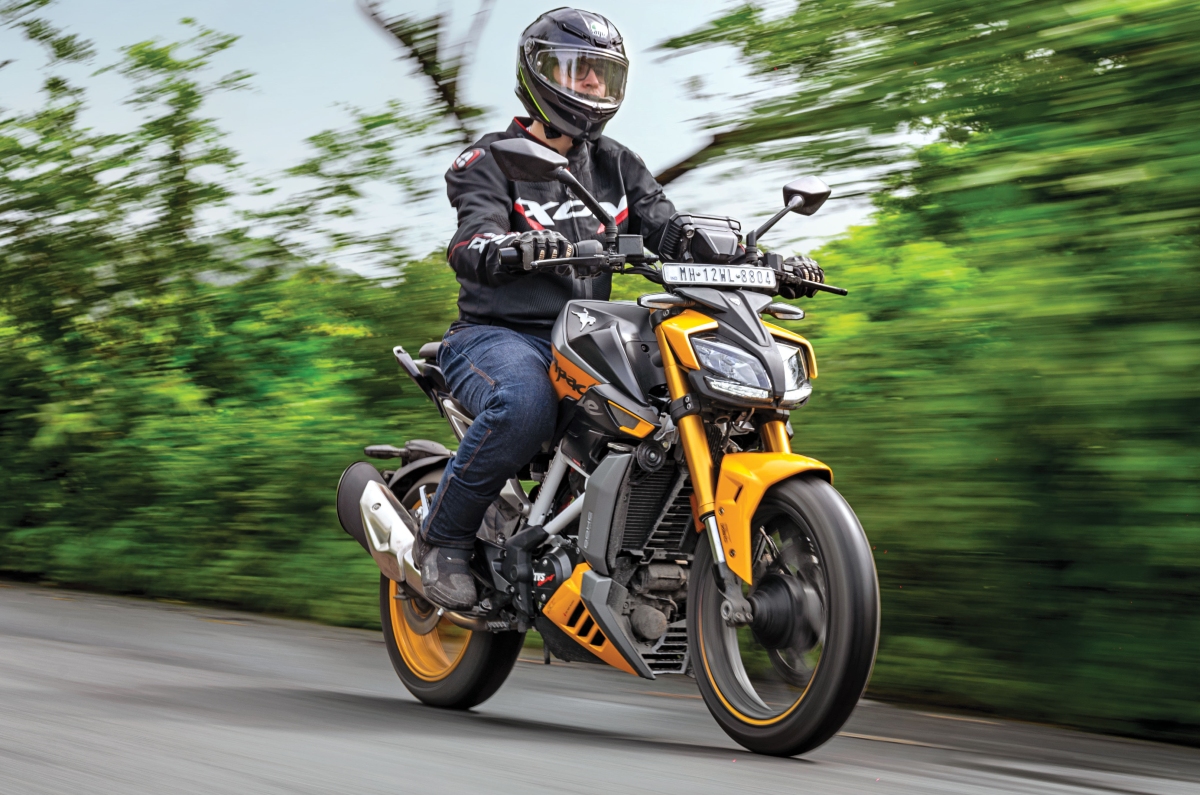
TVS Apache RTR 310 road test, review
October 1, 2024

When we rode the TVS Apache RTR 310 in Thailand last year, we had some complaints, which the company has now addressed via its ‘Carecraft’ service camp. Much to my chagrin, we did not experience the updated RTR 310 on dry, well-paved Thai roads. Instead, the setting was Mumbai during the peak of monsoon, which is when the roads start to go the way of the Dodo. To be fair, a bike tackling such roads in torrential rain is one of the best litmus tests there is, so let’s dive in.
Our main complaints last year were excessive vibration, an erratic quickshifter and an uncomfortable climate-controlled seat, and TVS now has fixes for all these issues. In a bid to quell the RTR 310’s buzz, the bike has been given larger bar-end weights and a revised tank mounting. The cooled seat’s padding has been changed to improve comfort. Finally, a revised throttle map and new routing for the quickshifter’s wiring eliminate random cut-offs.
But before we get down to brass tacks, let me refresh your memory about this handsome yellow bike. TVS has pulled out all the stops when it comes to features. Even the base variant comes standard with a TFT display, four riding modes (Track, Sport, Urban and Rain), an automatic LED headlight (which is very bright), traction control, switchable dual-channel ABS and cruise control, too!
Further, TVS’ accessory catalogue brings in a bidirectional quickshifter, climate-controlled seat, fully adjustable suspension, brass-coated chain, and more. The RTR 310 we tested missed out only on adjustable suspension and the brass-coated chain, so it was pretty well-specced.
So, have the changes made by TVS ironed out the chinks in the RTR 310’s armour? The short answer is yes (mostly). The vibrations are now better contained, and while the bike still isn’t ultra-smooth, the buzz is no longer a deal-breaker. The one area which still feels vibey is the grey rubber piece on the pillion seat, which gets buzzy at various rpms and sends a tingle up your back. The RTR 310’s quickshifter was already a pretty slick unit, and now it works seamlessly at all rpms.
The one issue that persists is the climate-controlled seat’s comfort. As innovative as it is, in under an hour, you’ll start to feel discomfort due to its stiffness. I respect TVS for trying something ingenious like this, but I have to recommend going with the standard seat. We also encountered a few stray instances of the bike stalling while taking off from a stop with gentle throttle inputs, which can get a little tiresome in big-city traffic.
Beyond that, the Apache RTR 310 remains an engaging yet reasonably comfortable bike to ride. A special mention must go to the excellent Michelin Road 5 rubber, which inspired loads of confidence in every scenario. The non-adjustable suspension struck a good balance between comfort and sportiness, and you don’t need the adjustable suspension, although it will help you fine-tune the setup to your liking.
The RTR 310 is the only model among the five TVS-BMW products on sale that makes 35.6hp and 28.7Nm of torque, compared to the other models’ 34hp/28Nm. TVS has also dramatically shortened the gearing on the RTR 310 compared to the RR, adding four more teeth to the rear sprocket.
The result? Punchy acceleration and a 0-100kph time that was narrowly quicker than the 40hp Triumph Speed 400’s. If you find yourself on a long enough stretch of road, you’ll see a speedo-indicated 160kph, maybe more if you’re lighter than me (I weigh 80kg without gear).
While Sport and Track modes give you the full juice, Rain and Urban temper down peak output to 27.1hp/27.3Nm, with gentler power delivery and more cautious intervention from the riding aids. The Rain and Urban settings should come in handy for newer riders or if you’re riding in inclement weather.
Thankfully, if you ever have to ride in less-than-ideal conditions, the brakes are strong and feedback-rich. The RTR 310 has one of the shortest stopping distances in this category (the superb Road 5s helping here, too). They have a gentle initial bite, but once you give the lever a firm tug, the bike slows down quickly. What’s pleasantly surprising is that the shorter gearing hasn’t impacted fuel economy much, and you can realistically get 300km on a tankful.
Thanks to the updates, the Apache RTR 310 now has noticeable improvements that make it more appealing. However, the top variant with all the bells and whistles is priced too close to the feisty KTM 390 Duke, so the RTR continues to feel a little out of its depth. That’s exactly why the Apache RTR 310 is one of the few motorcycles where the version we recommend is the base variant.
At Rs 2.50 lakh, the base (but still feature-rich) RTR 310 is now a very strong alternative to the likes of the Triumph Speed 400, KTM 250 Duke and Honda CB300R because you get much stronger performance along with fantastic style and more features at a comparable price.
——————————————————————————————————————–
Bull-LEDs | Guaranteed Custom
Contact us – https://bull-leds.com
This is a autogenerated feed from https://www.autocarindia.com/bike-reviews/tvs-apache-rtr-310-road-test-review-432982#utm_source=feed&utm_medium=rss&utm_campaign=Autocar+India+Bike+First+Drives+feed & Bull-LEDs do not have any ownership of the content.

